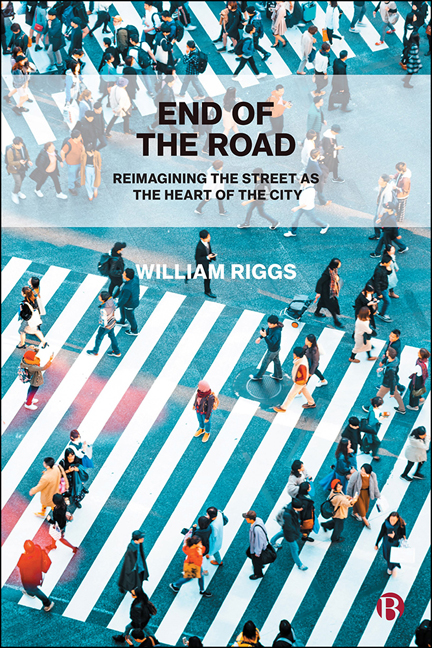Book contents
- Frontmatter
- Dedication
- Contents
- List of Figures and Tables
- Acknowledgments
- 1 Introduction
- 2 A Recent History of the Street
- 3 The Street for Transport
- 4 The Street as Economic Space
- 5 The Street as Social Space
- 6 The Street as Cultural Space
- 7 The Street as a Natural Space
- 8 Challenges to Ending the Road
- 9 Beyond Streets: Integrating Behavior
- 10 A Window into the Future: New Vehicles, New Streets
- 11 A Call to Action: Streets as the Heart of the City
- Appendix
- Notes
- References
- Index
1 - Introduction
Published online by Cambridge University Press: 12 October 2022
- Frontmatter
- Dedication
- Contents
- List of Figures and Tables
- Acknowledgments
- 1 Introduction
- 2 A Recent History of the Street
- 3 The Street for Transport
- 4 The Street as Economic Space
- 5 The Street as Social Space
- 6 The Street as Cultural Space
- 7 The Street as a Natural Space
- 8 Challenges to Ending the Road
- 9 Beyond Streets: Integrating Behavior
- 10 A Window into the Future: New Vehicles, New Streets
- 11 A Call to Action: Streets as the Heart of the City
- Appendix
- Notes
- References
- Index
Summary
We must kill the street! (Le Corbusier, 1930)
In around 1930, renowned architect Le Corbusier is attributed as saying that “we must kill the street.” Allegedly, the designer was almost struck by a car on the Champs- Elysées in Paris and took it upon himself to rethink city design and eliminate obsolete streets that were being taken over by cars. Lamenting how vehicles were overrunning the streets that had formerly been dedicated to living, playing and commerce, he decided they were obsolete. He chose to eliminate them. In his radiant city proposal, he suggested restricting human activities— living, working, playing, shopping and so on— to highrise towers and parks set apart from wide, motor roads for use only by cars.
While this vision of an auto-dependent city might sound like a contradiction to some, Corbusier’s obsession with streets is a good starting point. Despite where he ended, in removing all the human activity from the street, he started with an appreciation of what a street can be— the very heart of life in cities. He also chose to separate slower human travel from faster vehicular travel, which to a large degree has been adopted by the modern engineering profession.
In many ways, I have the same obsession with streets, but I don’t want to kill them. I don’t want to see human life eliminated from streets. In contradiction to the perspective of Corbusier, I hope to see the end of the road. I long for roads to evolve, or even devolve, to be safer, slower and more accommodative of all kinds of travelers and all kinds of activities.
Why is this? In many ways streets, whether they are paved or dirt, or in the US, China or South Africa, are the lifeblood of a city. The way they look, feel and how people behave when interacting with them— whether it be via walking, biking, transit or driving— is important to the very existence of how cities work. Yet, in many places, streets have become more like Corbusier’s roads than ever before. They are even more hostile than ever, particularly for people who want to walk or bike.
- Type
- Chapter
- Information
- End of the RoadReimagining the Street as the Heart of the City, pp. 1 - 15Publisher: Bristol University PressPrint publication year: 2022



